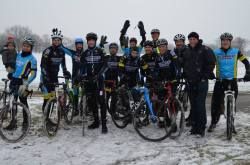Depending on the type of rider you are and your training background, group rides may make up a large component of your riding at certain times of the year or they may be something completely foreign to you. In the past, we have talked about the advantages and disadvantages of including group rides in the training program for more seasoned riders. Here we will offer some tips to help newer riders find an appropriate group and learn how best to fit into that ride.
If you have never been on a group ride before, you may feel intimidated by the size and speed of the group which may resemble organized (or unorganized) chaos. There are two basic patterns you will encounter on any group ride: 2x2 and rotating paceline.
Riding 2x2 is most practical for lower speeds up to about 22 mph. Two leaders ride side-by-side with the rest of the group lined up side-by-side behind them. The leaders pull for 2 to 5 minutes before pulling off to the outside of their lines and drifting to the back of the group. Simultaneously, the next two riders in line move up between the previous leaders and take up pace-making duties.
When the speed of the group picks up, a rotating paceline becomes a more efficient pattern of locomotion. This too starts with two parallel lines of riders, but instead of riding side-by-side, one line is advancing while the other is receding. As the first rider of the advancing line moves past the first rider in the receding line, he slides over into the receding line and makes his way to the back of the group as other riders in the advancing line continue moving up. When he gets to the back of the group, he accelerates slightly as he moves over to get back into the advancing line and repeats the process over and over. Often, as the pace picks up and riders fatigue, the number involved in the rotation diminishes and there may be a small group of riders riding side-by-side behind the rotating riders in the front. These are usually controlled by a “gate keeper” who maintains a steady gap behind the rotating riders.
In the case of either type of ride, remember this key acronym as you move off the front of the group: LSAP (Look, Signal, Accelerate, Pedal). First, as you finish your pull, double-check by glancing over your shoulder or under your armpit. Then make a small gesture that lets those riders behind you know you are preparing to pull off. Just before moving, accelerate slightly, just enough to ensure that you are clear of the wheel behind you. Finally, as you move to the back of the group, pedal softly so you do not decelerate too abruptly which could disrupt other riders in the group or cause you to have to work too hard to catch the tail of the group.
Many of us have been in a situation where we either come upon or are overtaken by a group and want to join in, but aren’t sure of the appropriate etiquette. One question you may ask is if the group is open to outside riders. Some teams or clubs may have private group rides only for their members. If you are welcomed, you should next inquire where the ride is headed and how hard they plan on riding. You certainly don’t want to follow the group somewhere you’re unfamiliar with only to be dropped when they speed up or if you have a mechanical problem. Finally, determine if there are any group customs, such as town-line sprints, established rest stops and so on, so that your actions don’t frustrate the group and cause them to be less welcoming to future visitors.
Now that the weather is changing, consider the opportunities that you have available to you to ride with a group. If you never have, it may be a nice change of pace to keep your training interesting. Whether it’s an intentional or incidental decision, keep the above tips in mind to make the experience beneficial for yourself as well as the rest of the group.

